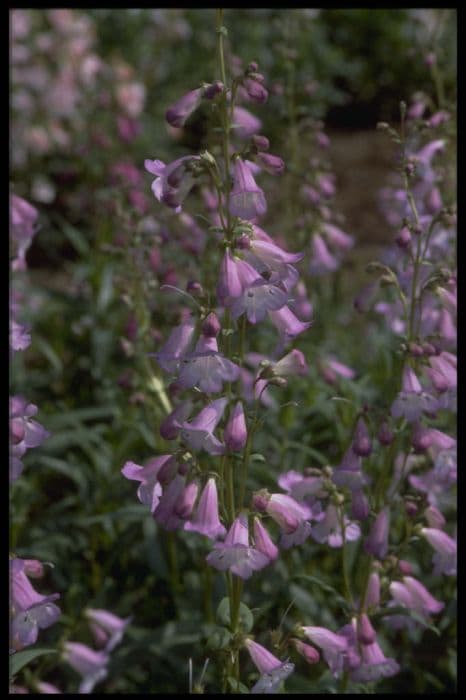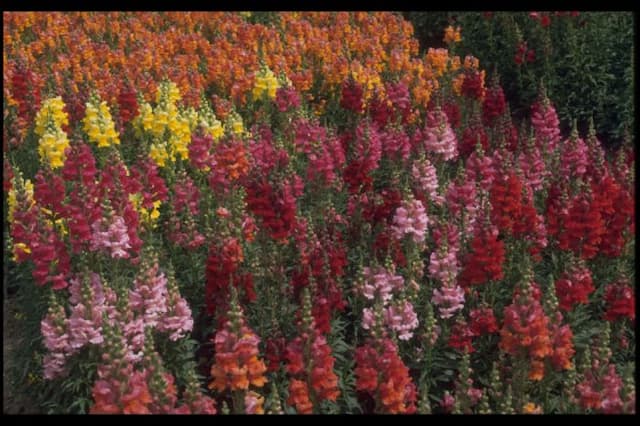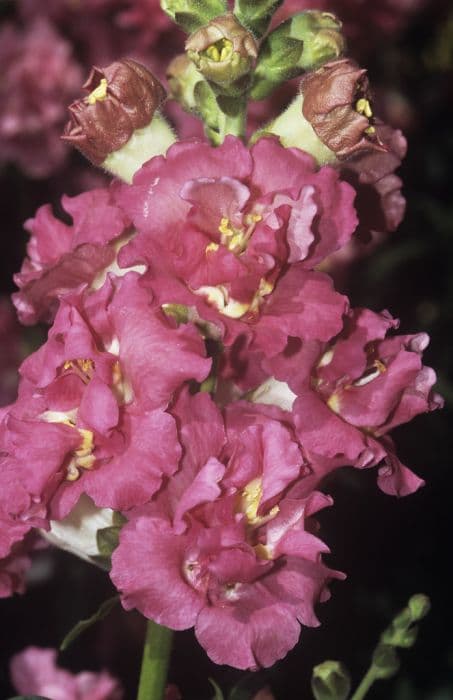Beardtongue Penstemon 'Alice Hindley'

ABOUT
Penstemon 'Alice Hindley' is a striking perennial plant known for its lush foliage and vibrant flowers. The leaves are lance-shaped and arranged in a dense, bushy formation, typically exhibiting a rich green color. This backdrop of foliage accentuates the beauty of the tubular flowers that bloom in profusion. These blossoms are a delicate pale mauve or lilac shade, with a white throat marked by streaks or lines of a darker purple hue, which act as nectar guides for pollinators. The flowers are arranged in tall, panicle-like clusters, presenting an eye-catching display that rises above the foliage. Each individual floret is composed of a wide, flared mouth which transitions to a narrower tube, a form that is well-suited for visiting bees and hummingbirds who drink the nectar. The overall appearance of the Penstemon 'Alice Hindley' is one of lushness and color, making it a popular choice for garden borders or as an accent plant, where its visually appealing attributes can be fully appreciated.
About this plant
 Names
NamesFamily
Plantaginaceae
Synonyms
Beardtongue
Common names
Penstemon 'Alice Hindley'
 Toxicity
ToxicityTo humans
The Penstemon, commonly referred to as Beardtongue, is not known to be toxic to humans. Therefore, ingesting parts of this plant typically should not lead to poisoning or adverse health effects.
To pets
The Penstemon, commonly known as Beardtongue, is not considered toxic to pets. It is generally safe and should not cause poisoning if pets happen to ingest parts of the plant.
 Characteristics
CharacteristicsLife cycle
Perennials
Foliage type
Semi-deciduous
Color of leaves
Green
Flower color
Mauve
Height
2-3 feet (60-90 cm)
Spread
1-2 feet (30-60 cm)
Plant type
Herb
Hardiness zones
5
Native area
North America
Benefits
 General Benefits
General Benefits- Attracts pollinators - Penstemon 'Alice Hindley' is known for attracting bees, butterflies, and other beneficial insects to the garden.
- Drought tolerant - Once established, this plant is relatively drought resistant, making it a good choice for xeriscaping and low-water gardens.
- Easy to grow - It is generally easy to care for and does not require complex maintenance, making it suitable for novice gardeners.
- Long blooming period - Penstemon 'Alice Hindley' offers an extended blooming period that can last from late spring to early fall, providing long-lasting color.
- Aesthetic appeal - With its tall spikes of mauve-blue flowers, this plant adds a vertical dimension and striking color contrast to garden beds and borders.
- Wildlife habitat - By providing nectar and pollen, it acts as a food source and habitat for wildlife, supporting biodiversity.
 Medical Properties
Medical PropertiesThis plant is not used for medical purposes.
 Air-purifying Qualities
Air-purifying QualitiesThis plant is not specifically known for air purifying qualities.
 Other Uses
Other Uses- Garden photography: Penstemon Alice Hindley's striking purple flowers and tall spikes make it a beautiful subject for garden photography enthusiasts.
- Educational tool: Botany teachers can use this species to explain pollination, as bees are particularly attracted to the flowers.
- Art inspiration: Artists can draw inspiration from the plant's form and color for paintings, illustrations, or textile designs.
- Dye source: The flowers might be used to create natural dyes for fabrics or artwork.
- Floral arrangements: Fresh or dried spikes can be used in bouquets or floral displays for their unique appearance.
- Bee gardens: Planting Penstemon Alice Hindley as part of a bee garden to support local pollinator populations.
- Sensory gardens:Due to its textured foliage and striking blooms, it can be incorporated into sensory gardens for touch and sight stimulation.
- Erosion control: Their root systems might help in stabilizing slopes and controlling erosion in certain landscapes.
- Theme gardens: It can be a part of themes like 'cottage gardens' or 'purple-flower' gardens due to its appearance.
- Winter interest: The dried seed heads can provide visual interest in the garden during the winter months.
Interesting Facts
 Feng Shui
Feng ShuiThe Beardtongue is not used in Feng Shui practice.
 Zodiac Sign Compitability
Zodiac Sign CompitabilityThe Beardtongue is not used in astrology practice.
 Plant Symbolism
Plant Symbolism- Resilience: Penstemon, also known as Beardtongue, often symbolizes resilience and the ability to survive in challenging conditions due to their natural habitat in North American deserts and mountain areas.
- Attraction: With its showy flowers, Beardtongue is commonly associated with attraction and charm, attracting not only the human eye but also hummingbirds and pollinators.
- Diversity: As there are many varieties of Penstemon, they can represent the beauty of diversity and variety in life.
- Health and Vitality: Since some species of Penstemon are used in traditional medicine, they can also be a symbol of health and vitality.
- Balance: The plant's ability to thrive in both sunny and partly shaded environments suggests a symbolic meaning of adaptability and balance.
 Water
WaterBeardtongue prefers well-drained soil and does not like to be overwatered. Water the plant once a week with about 1 gallon of water per plant, depending on the weather conditions. During hotter periods, you may need to water more frequently to ensure the soil doesn't completely dry out. Reduce watering to every other week during cooler months or if rain is prevalent. Ensure the water penetrates the soil to encourage deep rooting but allow the topsoil to dry out between waterings to prevent root rot.
 Light
LightBeardtongue thrives best in full sun to partial shade. A location that receives at least 6 hours of direct sunlight a day is ideal for this plant. If you live in a particularly hot climate, providing afternoon shade can help protect the plant from excessive heat.
 Temperature
TemperatureThe ideal temperature range for Beardtongue is between 55°F and 85°F. It can tolerate occasional dips in temperature down to about 20°F and can survive brief periods of higher temperatures as long as they are not prolonged. However, consistent temperatures outside of the ideal range may stress the plant and hinder growth.
 Pruning
PruningPruning Beardtongue promotes vigorous growth and encourages more blooms. Prune in early spring to remove any dead or damaged stems and again after the first wave of blooming to encourage a second bloom cycle. Deadheading spent flowers throughout the blooming season will also improve the plant’s appearance and vigor.
 Cleaning
CleaningAs needed
 Soil
SoilBeardtongue prefers well-draining soil with a neutral to slightly alkaline pH, ideally between 6.5 to 8.0. An ideal soil mix for Penstemon 'Alice Hindley' would consist of a combination of loam, sand, and compost to ensure good drainage and fertility.
 Repotting
RepottingBeardtongue plants like Penstemon 'Alice Hindley' generally do not need to be repotted often, as they prefer to be undisturbed. Repot every 2-3 years or when the plant outgrows its container.
 Humidity & Misting
Humidity & MistingBeardtongue prefers average to low humidity levels and does well in typical outdoor humidity conditions, so there is no need to adjust the humidity level specifically for Penstemon 'Alice Hindley'.
 Suitable locations
Suitable locationsIndoor
Ensure bright light, minimal water, and good air circulation.
Outdoor
Provide full sun, well-drained soil, and protect from severe cold.
Hardiness zone
5-9 USDA
 Life cycle
Life cyclePenstemon 'Alice Hindley', commonly referred to as Beardtongue, begins its life cycle with seed germination, which occurs in a well-draining soil mix under warm temperatures. Once emerged, the seedlings grow into juvenile plants sporting a rosette of leaves. During the growing season, the plant develops a sturdy stem and produces lance-shaped foliage, leading up to the flowering stage where it exhibits large, tubular violet-blue flowers that attract pollinators such as bees and hummingbirds. After pollination, the flowers develop into small capsules containing seeds, which ripen and are dispersed to begin a new generation. Penstemon 'Alice Hindley' is a perennial, and as such, after the blooming period it enters a phase of dormancy during the colder months, with the foliage dying back. The plant resumes growth the following spring from its rootstock, completing its life cycle and beginning anew.
 Propogation
PropogationPropogation time
Spring-Early Summer
The most popular method of propagating the Penstemon 'Alice Hindley', commonly known as Beardtongue, is through softwood cuttings. This is usually performed in late spring or early summer when the plant's new growth is just beginning to harden. Cuttings should be about 3 to 6 inches long with several leaf nodes. The lower leaves are removed, and the cut end is often dipped in rooting hormone to increase the chances of successful root development. The prepared cuttings are then placed in a well-draining soil mix, ensuring at least one or two nodes are below the surface. The environment should be kept humid, which can be achieved by covering the cuttings with a plastic bag or placing them in a propagator. Rooting typically takes place within a few weeks, after which the new plants can be gradually acclimatized to less humid conditions and eventually planted out.





![Snapdragon [Pretty in Pink]](/_next/image?url=https%3A%2F%2Fplants-admin.emdemapps.com%2Fimages%2Fplants%2F%2Fimages%2F604b5cb3b5385.png&w=640&q=75)



